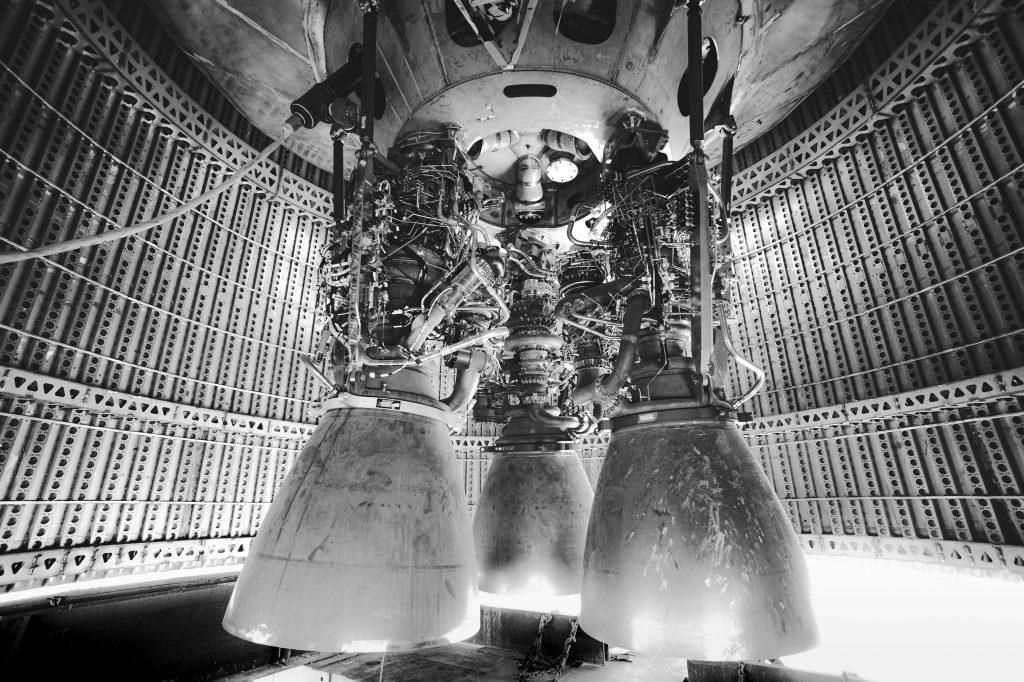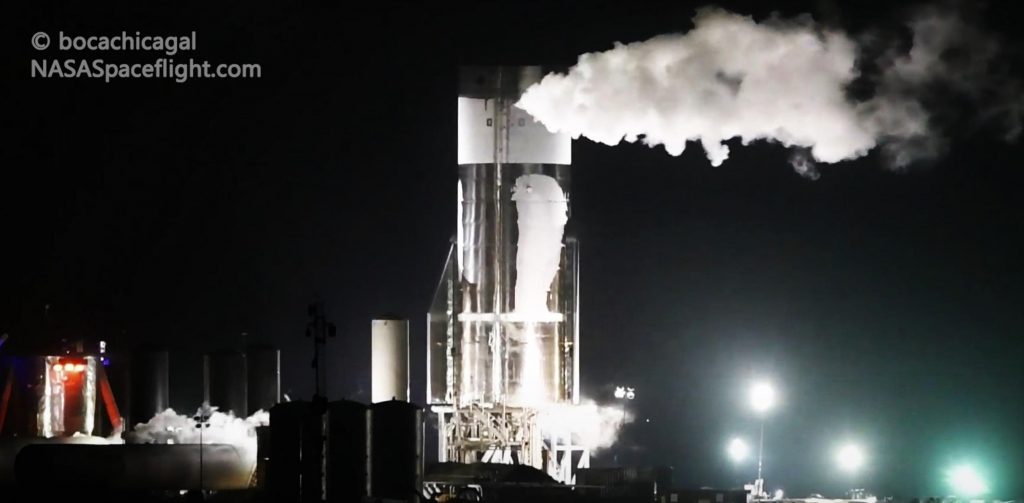

News
SpaceX schedules Starship’s first triple-Raptor static fire test
A photo posted by CEO Elon Musk confirms that SpaceX has successfully installed three functional Raptors on Starship SN8 just hours before road closure notices revealed the company’s first triple-engine static fire schedule.
Technically, it’s incorrect to say that Starship serial number 8 (SN8) is the first prototype to receive three Raptor engines. Back in late-September 2019, in the lead-up to Musk’s promised Starship update event, the company installed three Raptors on the first full-scale prototype, known as Starship Mk1. The engines were only installed as an apparent fit test or even a photo opportunity, however – evidenced by the fact that they weren’t actually plumbed to the Starship’s propellant tanks.
Even then, in September 2019, Starship Mk1 was far from ready to make use of Raptor engines and was more than a month away from attempting its first pressure and cryogenic proof tests – tests it quickly failed. As such, Starship SN8 – having more or less successfully passed its ‘cryo proof’ by October 9th – is undoubtedly the first ship to have a shot at igniting multiple Raptor engines at once.

Curiously, SpaceX remained quiet for several days after Starship SN8 passed its first big test. Whereas with past Starship prototypes SpaceX has often filed test plans (appearing in the form of road closures) even before the current phase of testing is complete, the company waited until Tuesday, October 14th to file closure notices for “SN8 static fire” testing.
Same as Starships SN4, SN5, and SN6, all of which successfully graduated from cryo proof to static fire testing (and even flight tests for the latter two), SpaceX began Starship SN8’s test campaign with a cryo proof. It took three days and at least as many attempts but SN8 ultimately “passed cryo proof” according to Elon Musk, likely meaning that the ship reached sustained pressures of 7.5 bar (~110 psi) or more.

Cryo proof complete, SpaceX installed Starship SN8’s engines – the first time multiple Raptors have been fully integrated with a rocket or test stand – in preparation for another Raptor first: multi-engine static fires. While modern computation fluid dynamics (CFD) and modeling mean that the great unknowns of rocket propulsion are rarely as opaque as they used to be, the first test of multiple powerful engines in close proximity is still a guaranteed recipe for surprises.
Thanks to expertise hard-won from nearly 100 Falcon 9 and Falcon Heavy launches, SpaceX is likely the world’s foremost expert in the challenges and dynamics of the proximity operation of more than two rocket engines. At the same time, though, Raptor is a dramatically different engine than Merlin 1D and while Starship will only have six engines at most, those six engines will produce thrust equivalent to almost two entire Falcon 9 boosters.

In other words, even with a (relatively) simple three-Raptor static fire, SpaceX will be treading new ground and will almost certainly end up learning one or several things about Raptor’s design and operation. More likely than not, SpaceX will begin Starship SN8’s static fire test campaign with a wet dress rehearsal (like a cryo proof but with real liquid methane and oxygen propellant) and transition into a Raptor spin prime (turbopump spin-up) or preburner test (a turbopump spin-up but with partial combustion) if the WDR goes smoothly. If all three Raptor engines appear healthy, SpaceX may recycle and attempt the first static fire just an hour or two later.
Starship SN8’s triple-Raptor static fire test window opened at 9pm CDT on October 14th and closes at 6am on the 15th, with an identical 9pm-6am backup on the 15th and another window from 8am to 4:30pm on the 16th. LabPadre (below) will continue to offer 24/7 views of Starship, including any static fire testing, while NASASpaceflight.com will likely provide live coverage once testing begins in earnest.

News
Tesla starts showing how FSD will change lives in Europe
Local officials tested the system on narrow country roads and were impressed by FSD’s smooth, human-like driving, with some calling the service a game-changer for everyday life in areas that are far from urban centers.

Tesla has launched Europe’s first public shuttle service using Full Self-Driving (Supervised) in the rural Eifelkreis Bitburg-Prüm region of Germany, demonstrating how the technology can restore independence and mobility for people who struggle with limited transport options.
Local officials tested the system on narrow country roads and were impressed by FSD’s smooth, human-like driving, with some calling the service a game-changer for everyday life in areas that are far from urban centers.
Officials see real impact on rural residents
Arzfeld Mayor Johannes Kuhl and District Administrator Andreas Kruppert personally tested the Tesla shuttle service. This allowed them to see just how well FSD navigated winding lanes and rural roads confidently. Kruppert said, “Autonomous driving sounds like science fiction to many, but we simply see here that it works totally well in rural regions too.” Kuhl, for his part, also noted that FSD “feels like a very experienced driver.”
The pilot complements the area’s “Citizen Bus” program, which provides on-demand rides for elderly residents who can no longer drive themselves. Tesla Europe shared a video of a demonstration of the service, highlighting how FSD gives people their freedom back, even in places where public transport is not as prevalent.
What the Ministry for Economic Affairs and Transport says
Rhineland-Palatinate’s Minister Daniela Schmitt supported the project, praising the collaboration that made this “first of its kind in Europe” possible. As per the ministry, the rural rollout for the service shows FSD’s potential beyond major cities, and it delivers tangible benefits like grocery runs, doctor visits, and social connections for isolated residents.
“Reliable and flexible mobility is especially vital in rural areas. With the launch of a shuttle service using self-driving vehicles (FSD supervised) by Tesla in the Eifelkreis Bitburg-Prüm, an innovative pilot project is now getting underway that complements local community bus services. It is the first project of its kind in Europe.
“The result is a real gain for rural mobility: greater accessibility, more flexibility and tangible benefits for everyday life. A strong signal for innovation, cooperation and future-oriented mobility beyond urban centers,” the ministry wrote in a LinkedIn post.
News
Tesla China quietly posts Robotaxi-related job listing
Tesla China is currently seeking a Low Voltage Electrical Engineer to work on circuit board design for the company’s autonomous vehicles.

Tesla has posted a new job listing in Shanghai explicitly tied to its Robotaxi program, fueling speculation that the company is preparing to launch its dedicated autonomous ride-hailing service in China.
As noted in the listing, Tesla China is currently seeking a Low Voltage Electrical Engineer to work on circuit board design for the company’s autonomous vehicles.
Robotaxi-specific role
The listing, which was shared on social media platform X by industry watcher @tslaming, suggested that Tesla China is looking to fill the role urgently. The job listing itself specifically mentions that the person hired for the role will be working on the Low Voltage Hardware team, which would design the circuit boards that would serve as the nervous system of the Robotaxi.
Key tasks for the role, as indicated in the job listing, include collaboration with PCB layout, firmware, mechanical, program management, and validation teams, among other responsibilities. The role is based in Shanghai.
China Robotaxi launch
China represents a massive potential market for robotaxis, with its dense urban centers and supportive policies in select cities. Tesla has limited permission to roll out FSD in the country, though despite this, its vehicles have been hailed as among the best in the market when it comes to autonomous features. So far, at least, it appears that China supports Tesla’s FSD and Robotaxi rollout.
This was hinted at in November, when Tesla brought the Cybercab to the 8th China International Import Expo (CIIE) in Shanghai, marking the first time that the autonomous two-seater was brought to the Asia-Pacific region. The vehicle, despite not having a release date in China, received a significant amount of interest among the event’s attendees.
Elon Musk
Elon Musk and Tesla AI Director share insights after empty driver seat Robotaxi rides
The executives’ unoccupied tests hint at the rapid progress of Tesla’s unsupervised Robotaxi efforts.

Tesla CEO Elon Musk and AI Director Ashok Elluswamy celebrated Christmas Eve by sharing personal experiences with Robotaxi vehicles that had no safety monitor or occupant in the driver’s seat. Musk described the system’s “perfect driving” around Austin, while Elluswamy posted video from the back seat, calling it “an amazing experience.”
The executives’ unoccupied tests hint at the rapid progress of Tesla’s unsupervised Robotaxi efforts.
Elon and Ashok’s firsthand Robotaxi insights
Prior to Musk and the Tesla AI Director’s posts, sightings of unmanned Teslas navigating public roads were widely shared on social media. One such vehicle was spotted in Austin, Texas, which Elon Musk acknowleged by stating that “Testing is underway with no occupants in the car.”
Based on his Christmas Eve post, Musk seemed to have tested an unmanned Tesla himself. “A Tesla with no safety monitor in the car and me sitting in the passenger seat took me all around Austin on Sunday with perfect driving,” Musk wrote in his post.
Elluswamy responded with a 2-minute video showing himself in the rear of an unmanned Tesla. The video featured the vehicle’s empty front seats, as well as its smooth handling through real-world traffic. He captioned his video with the words, “It’s an amazing experience!”
Towards Unsupervised operations
During an xAI Hackathon earlier this month, Elon Musk mentioned that Tesla owed be removing Safety Monitors from its Robotaxis in Austin in just three weeks. “Unsupervised is pretty much solved at this point. So there will be Tesla Robotaxis operating in Austin with no one in them. Not even anyone in the passenger seat in about three weeks,” he said. Musk echoed similar estimates at the 2025 Annual Shareholder Meeting and the Q3 2025 earnings call.
Considering the insights that were posted Musk and Elluswamy, it does appear that Tesla is working hard towards operating its Robotaxis with no safety monitors. This is quite impressive considering that the service was launched just earlier this year.








